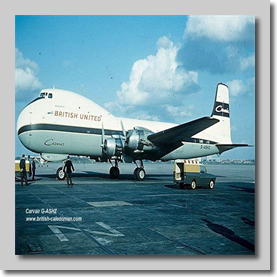The ATL - 98 Carvair - Pt 2
If you have any photos or info you can add, please feel free to drop me a line anytime evswitch@aol.com

The Aviation Traders ATL-98 was a hydrid aircraft, essentially a Douglas DC-4, with a custom built tail section, an extended and enlarged nose with a front opening clam-type door.
The Carvair entered commercial service on 17th February 1962 when G-ANYB flew a charter to Malaga, the first scheduled service was Southend-Rotterdam on 1st March 1962. Inaugural flights to Geneva followed on 2nd April and Basle on 6th April.
On the first day of services to Geneva, two Carvairs made the journey, the first carrying five white cars headed by a 1910 Silver Ghost Rolls Royce, followed by a Ford Classic, an MG Midget, a Vauxhall VX 490 and a Sunbeam Alpine. The second flight arrived a few minutes later, carrying the first scheduled passengers and their four cars.
The Carvair entered commercial service on 17th February 1962 when G-ANYB flew a charter to Malaga, the first scheduled service was Southend-Rotterdam on 1st March 1962. Inaugural flights to Geneva followed on 2nd April and Basle on 6th April.
On the first day of services to Geneva, two Carvairs made the journey, the first carrying five white cars headed by a 1910 Silver Ghost Rolls Royce, followed by a Ford Classic, an MG Midget, a Vauxhall VX 490 and a Sunbeam Alpine. The second flight arrived a few minutes later, carrying the first scheduled passengers and their four cars.

Here we have quite a rare image of G-ANYB while she was still a DC-4, here in service with Air Charter Ltd.
She arrived in February 1955 and was used on the 2nd Berlin Airlift
Air Charter operated the Channel Air Bridge service, and following the takeover by Airwork, the Channel Air Bridge name was used as the airline name from 1959, though BUA titles were applied after BUA's formation.
The Channel Air Bridge name finally disappeared with the formation of British United Air Ferries on 1st January 1963.
She arrived in February 1955 and was used on the 2nd Berlin Airlift
Air Charter operated the Channel Air Bridge service, and following the takeover by Airwork, the Channel Air Bridge name was used as the airline name from 1959, though BUA titles were applied after BUA's formation.
The Channel Air Bridge name finally disappeared with the formation of British United Air Ferries on 1st January 1963.

Carvair G-ARSF was the 3rd Carvair to be delivered in July 1962
She was lost on 28th Decemeber 1962 whilst attempting a landing in heavy snow at Rotterdam
Sadly one crew member was lost when she landed short of the runway.
The seventeen passengers and the remaining crew all survived.
She was lost on 28th Decemeber 1962 whilst attempting a landing in heavy snow at Rotterdam
Sadly one crew member was lost when she landed short of the runway.
The seventeen passengers and the remaining crew all survived.
Carvair G-ARSD reached journey's end in April 1968 when she was withdrawn, ending her days at Lydd (or Ferryfield)
fittingly where cross-channel vehicle services started way back in July 1948 with Silver City.
fittingly where cross-channel vehicle services started way back in July 1948 with Silver City.


















